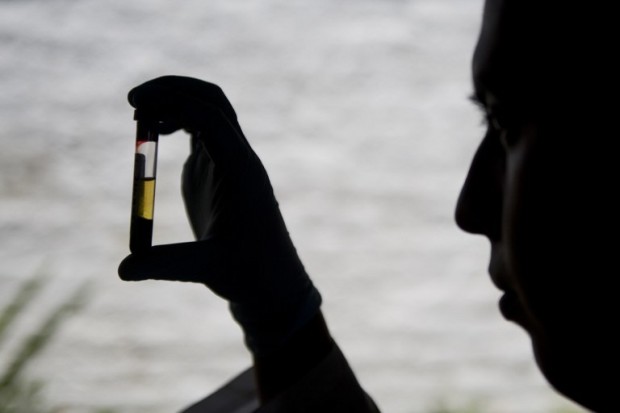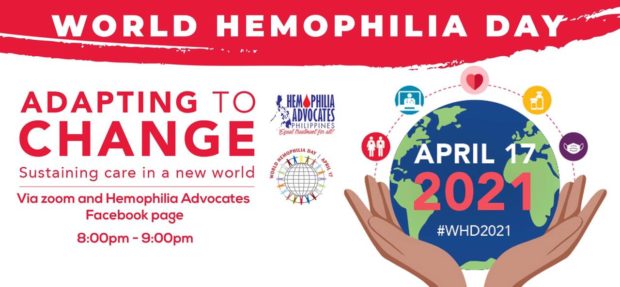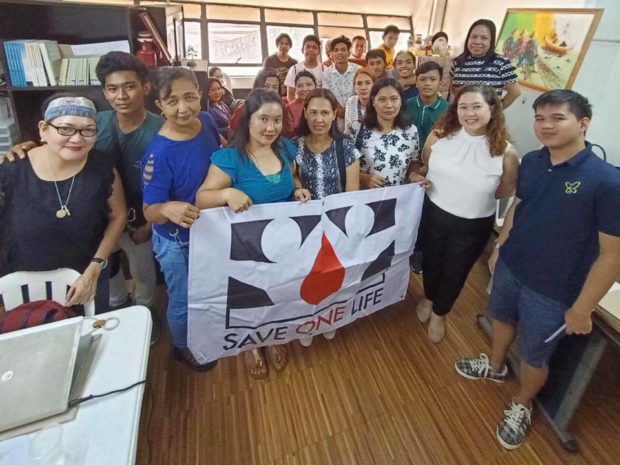EXPLAINER: Five things you need to know about hemophilia

(FILES) This file photo taken on April 26, 2012 shows a scientist looking at a blood sample in a laboratory at the Center for Scientific Research Caucaseco in the outskirts of Cali, Colombia.
AFP PHOTO / LUIS ROBAYO
MANILA, Philippines — Through Proclamation No. 1478 signed by then-President Gloria Macapagal-Arroyo in 2008, April was declared National Hemophilia Awareness Month, and April 17 as National Hemophilia Day.
In celebration of National Hemophilia Day, here are some things you need to know about this rare type of bleeding disorder.
What is hemophilia?
According to the Centers for Disease Control and Prevention (CDC), hemophilia is a bleeding disorder in which the blood can not clot properly. This can cause spontaneous and prolonged bleeding following an injury or surgery.
Hemophilia is a rare genetic disorder. However, CDC noted that it can also be developed later in life.
“The majority of cases involve middle-aged or elderly people or young women who have recently given birth or are in the later stages of pregnancy. This condition often resolves with appropriate treatment,” said CDC on its website.
Article continues after this advertisementThe U.S.-based nonprofit organization Mayo Clinic said at least 30 percent of people with hemophilia “have no family history of the disorder.”
Article continues after this advertisement“Acquired hemophilia is a rare variety of the condition that occurs when a person’s immune system attacks clotting factors in the blood,” it stated on its website.
Acquired hemophilia can be associated with pregnancy, autoimmune conditions, cancer, and multiple sclerosis.
Andrea Trinidad, president of Hemophilia Advocates-Philippines (HAP) explained hemophilia can also be present even without such history of the ailment in the family.
“Yung mutation from birth talaga, nagmutate yung genes niya so pagkapanganak sa kanya may hemophilia na siya kahit walang family history,” Trinidad told INQUIRER.NET in a phone interview.
(Mutated starts at birth. When the baby is delivered, he or she already have hemophilia even without family history.)

Andrea Trinidad, president of Hemophilia Advocates-Philippines, awards $700 Micro-Enterprise Grant to Rolly Marsula who has Hemophilia A. Image from Trinidad-Chavez’s Facebook account
“Nagmu-mutate, either nag-mutate siya doon sa mother na carrier or doon sa bata mismo. Pwede kasing ganon na walang family history, nag mutate lang siya,” she added.
(It mutated either from the mother or the baby. It’s possible to mutate even without a family history.)
Two types of hemophilia
There are two types of hemophilia. First is Hemophilia A or Classic Hemophilia, which according to CDC is caused by lack of clotting factor eight.
On the other hand, Hemophilia B, or the Christmas Disease, is caused by lack of clotting factor nine.
Hemophilia Advocates Philippines (HAP), a non-profit organization led by persons with hemophilia as well as family members and advocates, explained that Hemophilia A is the most common type of hemophilia.
At least eight out of 10 people with hemophilia have Hemophilia A, the organization said on its website.
Common symptoms of hemophilia
The CDC and National Hemophilia Foundation cited the following as the common signs and symptoms of the bleeding disorder:
- Bleeding into joints – usually the knees, elbows, or ankles – can lead to “swelling and pain or tightness in the joints” according to the CDC.
- Bruising or hematoma or a build-up of blood in an affected area.
- Prolonged bleeding from minor cuts or injuries
- Excessive bleeding after minor surgery, blood draws, or dental procedures.
- Nosebleeds that are frequent and hard to control.
- Blood in the urine or stool.
Who are afflicted?
Hemophilia, according to CDC, occurs in “one of every 5,000 male births.”
However, while it is more common among men, women can also be diagnosed with the disorder.
Based on the 2019 report by The World Hemophilia Federation, out of the 157,517 patients across 115 countries that were diagnosed with Hemophilia A, 137,574 or 87 percent are male while 5,604 or four percent are female.
Meanwhile, 27,416 or 86 percent of the 31,997 patients with Hemophilia B are men while 1,907 or six percent are female.
In the Philippines, The World Hemophilia Federation’s data bared that 1,566 Filipinos have hemophilia. Around 46 meanwhile have Willebrand disease – the most common bleeding disorder caused by missing or defective von Willebrand factor (vWF).
However, it was earlier estimated that there could be some 10,000 Filipinos affected with hemophilia and around one million others with von Willebrand Disease and other clotting factor deficiency disorders.
Trinidad attributed this low count of Filipinos diagnosed with hemophilia to the expensive laboratory examinations fees as well as the lack of diagnostics in the country.
“Kasi mahal yung magpa factor assays, yung sa diagnostics. Mahal siya so mababa lang talaga yung nada-diagnose,” she said.
“Kasi mahal yung magpa factor assays, yung sa diagnostics. Mahal siya so mababa lang talaga yung nada-diagnose,” she said.
(It’s expensive to undergo the factor assays for diagnostics. It’s costly that’s why only few are being diagnosed with hemophilia.)
“I was diagnosed not here in the Philippines. Yung anak ko was diagnosed sa Hong Kong. Kulang talaga tayo ng diagnostic sa Philippines,” she claimed.
(I was not diagnosed here in the Philippines. My child was diagnosed in Hong Kong. We really lack diagnostics in the Philippines.)
Treatment
There is currently no cure for hemophilia. However, there are several treatments available for patients.
Replacement therapy, considered as the main treatment for severe hemophilia, replaces the missing blood clotting factor so that the blood can clot properly.
Both CDC and Mayo Clinic said that this type of treatment is administered intravenously.
“This replacement therapy can be given to combat a bleeding episode that’s in progress. It can also be administered on a regular schedule at home to help prevent bleeding episodes. Some people receive continuous replacement therapy,” said Mayo Clinic.
“Replacement clotting factor can be made from donated blood. Similar products, called recombinant clotting factors, are manufactured in a laboratory and aren’t made from human blood,” it added.
Other treatments include:
- Desmopressin, a hormone that stimulates the body to release more clotting factors. The hormone is usually injected into a vein or given as a nasal spray
- Clot-preserving medications
- Fibrin sealants
- Physical therapy
- First aid for minor cuts
- Vaccinations against other diseases such as hepatitis A and B

